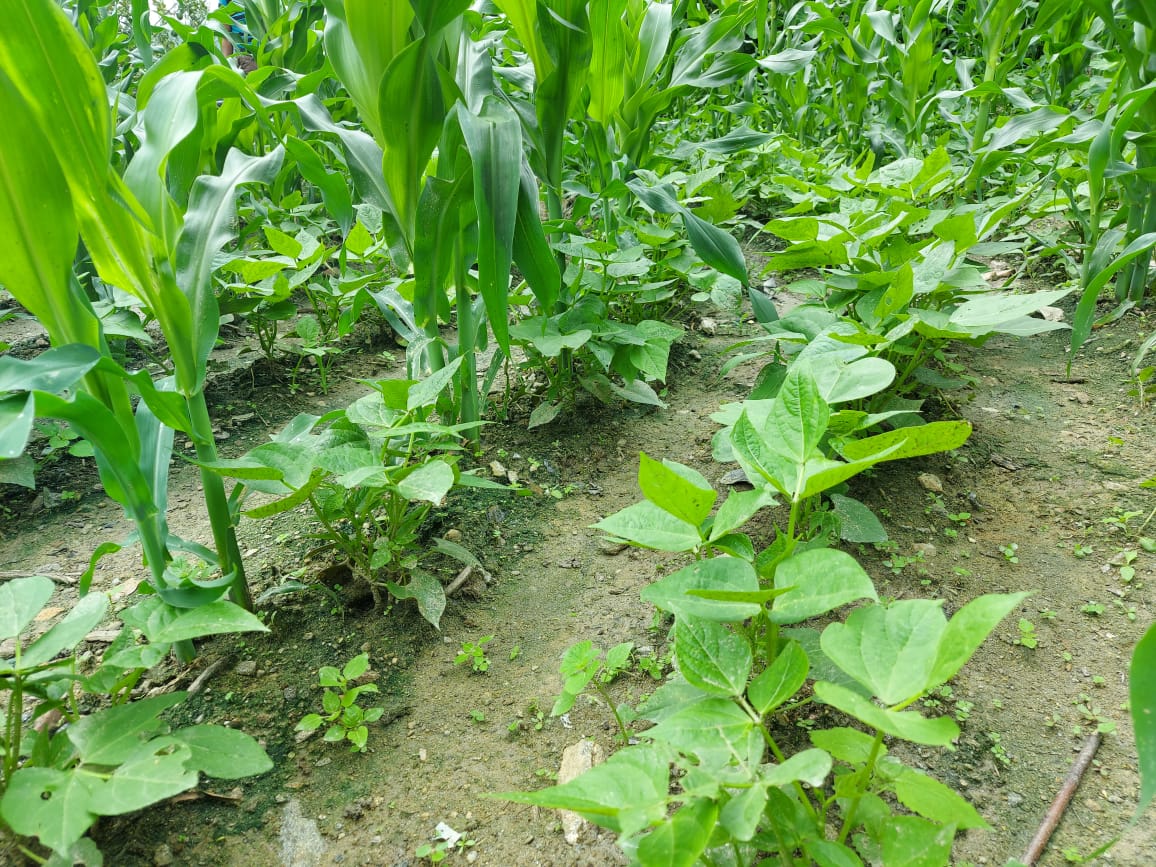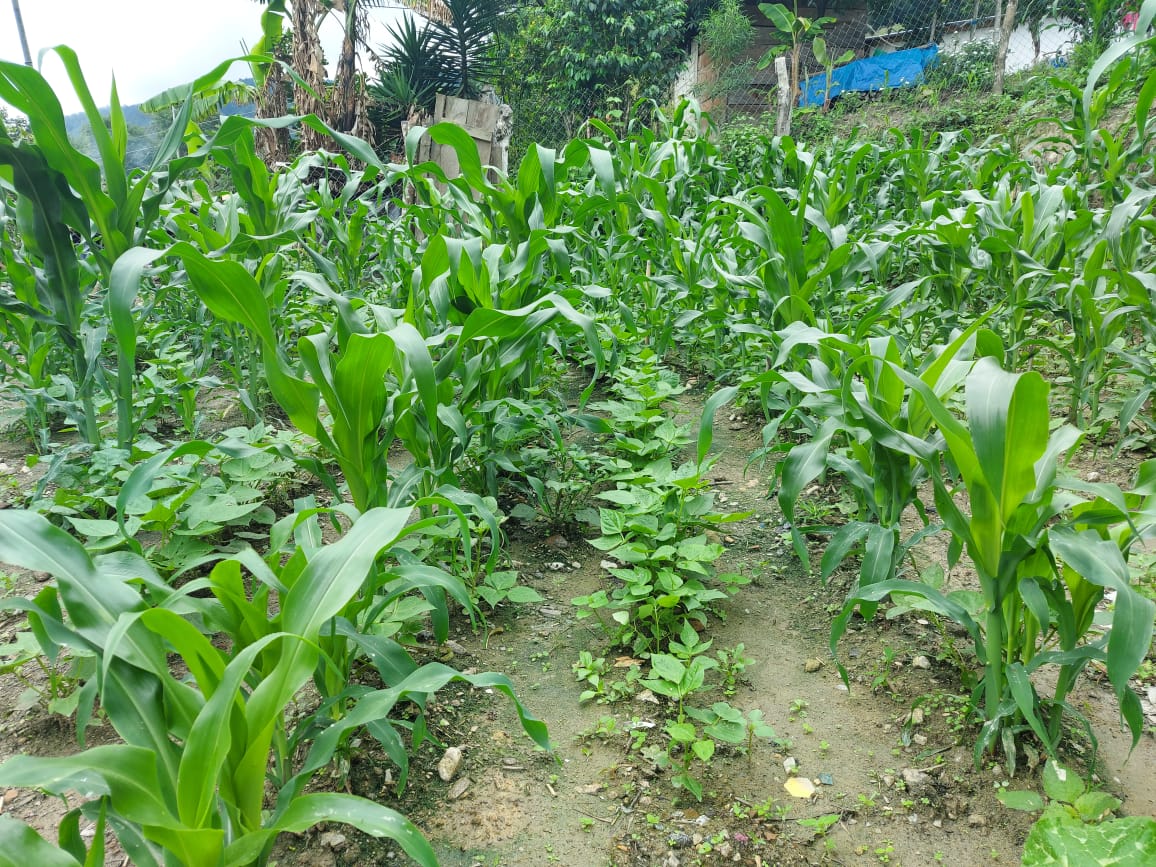Decolonizing Agriculture
in Guatemala
by Rebecca Cutter
June 30, 2020

Ab’iix is an intensive agricultural system used throughout Mesoamerica that produces high yields of food crops and medicinal plants using native seeds, natural fertilizers and integrated pest management. In Guatemala, however, Ab’iix is more commonly known as “milpa.” This is actually a Nahuatl (Indigenous from Mexico) word meaning “cultivated field.” Many names in Guatemala are in the language of the Nahuatl guides who traveled South from Mexico into Guatemala accompanying Spanish Conquistadors In the early 1500s. In fact, the word Guatemala roughly translates to “place of the trees” in Nahuatl. There’s a movement among many Guatemalans to decolonize the name of their country by changing it to Ixim Uleu, which translates to “land of the corn” in most of the 23 Mayan languages. Further North, Ab’iix is known as The Three Sisters: Corn, Beans, and Squash.
To understand why so many farmers abandoned such a productive agricultural system I give you this simplified, highly digestible history of colonization and its impacts on agriculture in Guatemala.
The First Agricultural Revolution began when hunter-gatherers shifted toward subsistence farming. According to historians, approximately 6,000 years ago the Maya began cultivating the wild teosinte to grow what is now known as maize or corn. They developed highly productive agricultural systems like Ab’iix and Chinampas, the floating gardens. In Guatemala, the Second Agricultural Revolution, which coincided with the 19th-century industrial revolution, introduced mechanization, and in Guatemala, the expropriation of Maya land for the establishment of large plantations. Toward the end of the 19th century, President Barrios abolished communal ownership of land altogether. Many displaced Maya worked as indentured servants on plantations that exported crops like cotton, indigo, sugar, rubber, coffee, and bananas. This turn toward monocultural, export-cropping, devastated Maya agricultural systems.
The “Green” Revolutions
In the mid-20th century, post-WWII, The Third Agricultural Revolution, also known as the Green Revolution, brought hybrid seeds, and chemical fertilizers and pesticides to rural farmers in Guatemala. These development packages, delivered by government and international aid organizations as free hand-outs under the guise of poverty alleviation, quickly overtook traditional agricultural practices. Roughly 15 years later, in the 1970s, the cost of these once subsidized government hand-outs drove many farmers, who could not afford them, to abandon farming for seasonal migration to plantations. Farmers, who for over 2,500 years saved and planted their heritage seeds, saw a rapid loss in plant diversity. This period overlaps with the country’s 36-year armed conflict which was primarily a fight for land reform.
In the late 20th century, with the Second Green Revolution, we saw the introduction of genetically modified organisms, (GMOs). Particularly devastating to the Maya was the introduction of GMO corn seed which can cross-pollinate with native corn, making it impossible to save the seeds. While native crops are naturally climate-resilient, hybrid and GMO crops are dependent on chemical fertilizers and pesticides which poison the soil, water, air, and food.
Today, Maya Achi communities face food insecurity as recurring droughts and extreme weather devastates crops. International markets for export crops are collapsing and COVID-19 has communities on lockdown with little access to local markets. For Julian Vasquez Chun, this crisis gives rise to opportunity or as we say in Permaculture, “The Problem is the Solution.”
Maya Achi communities face food insecurity as droughts and extreme weather devastates crops, international markets for export crops collapse, and COVID-19 has communities on lockdown.
Campesino a Campesino (Farmer to Farmer)
In his community of El Sauce, the only community where he can work during the COVID-19 lockdown, Julian has begun a comparative study of the conventional cornfield and the traditional Abi’ix. The purpose of this study is to demonstrate the differences in input and output of the two agricultural systems so that farmers can decide for themselves which is more productive and healthier for the Earth and the people. Julian is also documenting along the way, the rich agricultural history of his people in order to preserve this knowledge and share it with a new generation of farmers.
Using Campesino a Campesino (farmer to farmer) methodology for sharing traditional knowledge and best practices, Julian hopes to see a significant shift in agricultural practices in his community.

The study looks at social and environmental indicators, like the soil classification, access to water, pests, square meters of land under cultivation, and the history of agricultural practices on the land. It also looks at the preparation of the land, cultivation, harvests, and costs of production.
Ten participating farmers are cultivating two fields each of equal size and similar conditions, one with the traditional Abi’ix which is a diverse planting of open-pollinated native seeds, and the other with conventional agriculture practices and hybridized, “improved” corn seed. This is an extensive study that’s as much qualitative as it is quantitative. It takes into consideration the importance of clean air, water, healthy soil, and food, the preservation of traditional knowledge, and heritage seeds.
Unfortunately, the recent billion-dollar settlement to farmers in the U.S. who developed cancer from the use of Monsanto’s Roundup, won’t deter farmers in Guatemala from continuing to use these harmful products. Their health and the health of their environment depends on making the shift toward more regenerative agriculture with its roots in traditional farming.
At The Garden’s Edge, we’ve seen the benefits of the Abi’ix over the better half of two decades. This highly intensive, integrative system produces a wide variety of food plants and plant medicines. The health of people and their environment depends on making the shift toward more regenerative agriculture.




